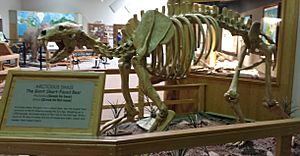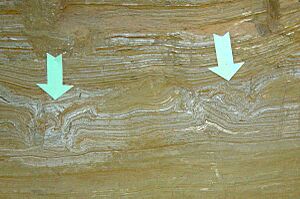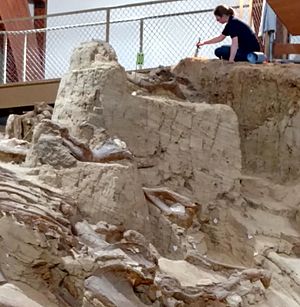The Mammoth Site facts for kids
Quick facts for kids The Mammoth Site |
|
|---|---|
| Lua error in Module:Location_map at line 420: attempt to index field 'wikibase' (a nil value). | |
| Location | Hot Springs, South Dakota |
| Designated | 1980 |
The Mammoth Site is a cool museum and a place where scientists dig up old bones, called a paleontological site. It's located near Hot Springs, South Dakota, in the beautiful Black Hills. Scientists are still actively digging and learning new things here today!
The main building covers a giant hole in the ground, called a sinkhole. This sinkhole formed long, long ago during the Ice Age (Pleistocene era) and slowly filled up with dirt and mud. Inside this dirt, scientists have found the bones of ancient animals (fauna) and even plants (flora) from the Ice Age. These creatures got trapped and buried in the sinkhole, which helped preserve them.
As of 2016, researchers had found the remains of 61 mammoths here. Most of these were Columbian Mammoths, but three Woolly mammoths were also discovered. The first mammoth bones were found in 1974. Soon after, a museum and a building were built around the site to protect it. Today, the museum has an amazing collection of mammoth remains for everyone to see.
Contents
How the Mammoth Site Sinkhole Formed
During the late Ice Age, the sinkhole at The Mammoth Site began to form. It happened when a cave in the Minnelusa Limestone rock collapsed. This collapse created a deep hole with very steep sides. The sinkhole was at least 65 feet (20 meters) deep. It was also about 120 feet (37 meters) by 150 feet (46 meters) wide at the top.
This sinkhole was like a chimney, allowing warm water from underground springs to bubble up. This warm water filled the sinkhole, creating a pond with steep, slippery sides.

Scientists believe this pond slowly filled with silt (fine dirt) over 350 to 700 years. They found worm burrows and mammoth footprints in the dirt. This shows that the dirt and mammoth bones built up slowly over a long time.
Mammoths were likely drawn to the pond because of its warm water and tasty plants. They would enter to eat, drink, or bathe. But the sides of the sinkhole were very steep and slippery. Sometimes, when the water level was low, mammoths would get stuck. They couldn't find a way to climb out. Trapped in the sinkhole, these mammoths eventually died from hunger, exhaustion, or by drowning.
Eventually, the sinkhole completely filled up with dirt. The warm spring water then found a new path to the nearby Fall River. Over thousands of years, the hardened mud inside the old pond stayed strong. The land around it slowly wore away, leaving the sinkhole as a raised area on the landscape.
Ancient Animals Found at the Site
The warm spring-fed pond was a popular spot for many animals. Scientists have found bones from many different creatures here. These include giant short-faced bears, shrub oxen, American camels, llamas, wolfes, coyotes, and various birds. Smaller animals like minks, ferrets, prairie dogs, voles, and moles were also found. Even tiny creatures like clams, snails, and slugs have been discovered.
Most of the mammoth bones belong to Columbian Mammoths. However, the remains of three Woolly mammoths have also been found. It was very hard for mammoths to escape once they slipped into the sinkhole. Scientists have studied the hip bones of the mammoths found. They learned that most of the trapped mammoths were young males.
Modern elephants live in groups led by older females. Young males often leave these groups and take more risks. Scientists think this might explain why so many young male mammoths ended up trapped in the sinkhole. They might have been more adventurous and less careful.
Dating the Mammoth Site Discoveries
When The Mammoth Site was first discovered, scientists thought it was about 20,000 years old. This estimate was based on the types of animal bones found with the mammoths. Finding remains of Ice Age bears, camels, and shrub-oxen suggested the sinkhole was filled during the late Ice Age.
Scientists have tried different ways to figure out the exact age of the site. Early attempts to use radiocarbon dating on mammoth bones didn't work well. Later, they tried dating parts of the bone called apatite. These tests gave ages around 19,000 to 26,000 years old. For a long time, many researchers used about 26,000 years as the age for when the mammoths and dirt filled the sinkhole. However, scientists now know that dating bone apatite can be unreliable. It often gives an age that is too young.
Because of these challenges, scientists used other methods. They dated a mammoth tooth using uranium-series dating, which suggested an age of about 129,000 years. They also used thermoluminescence (TL) and optically stimulated luminescence (OSL) on the dirt around the bones. Early OSL results suggest the sinkhole and its contents are indeed much older than 26,000 years. This means the mammoths lived and died here much earlier in the Ice Age than first thought.
The Mammoth Site Museum
In 1974, a construction worker named George Hanson was preparing land for new houses. He dug up some unusual bones. His son recognized one of them as a mammoth tooth!
The landowner, Phil Anderson, agreed to let scientists investigate further. In 1974, a complete mammoth skull and tusk were found. Phil Anderson generously donated the entire bone bed and mineral rights to a non-profit organization. With the help of many amateur and professional diggers, the site became a museum. In 1980, it was named a National Natural Landmark. At first, scientists mapped the finds using a string grid. Now, they use advanced computer technology to map everything.
The Mammoth Site is a non-profit organization. The museum is open to the public, so anyone can visit and learn. Volunteers from Earthwatch Institute even help with the digs during July. Scientists from all over the world, including Mexico, Italy, and Germany, have visited to study the finds. The museum also displays tools from ancient people, like those from the Clovis culture and Folsom people. It also offers educational programs for students of all ages.
See also
- La Brea tar pits
- List of mammoths
- Waco Mammoth National Monument



